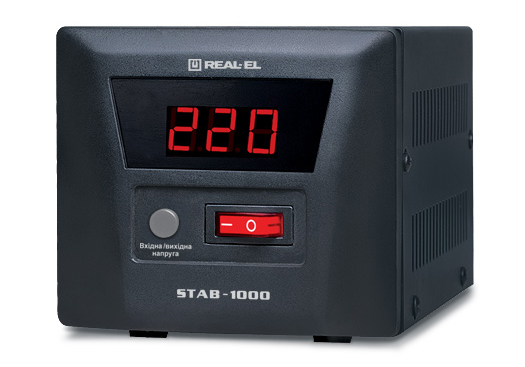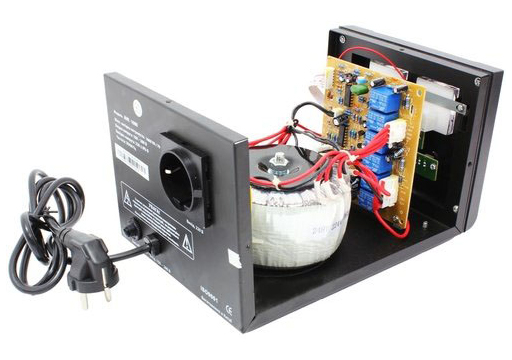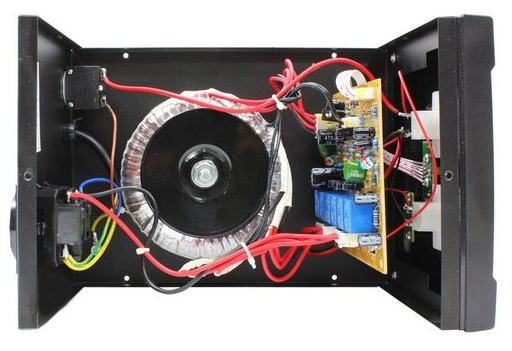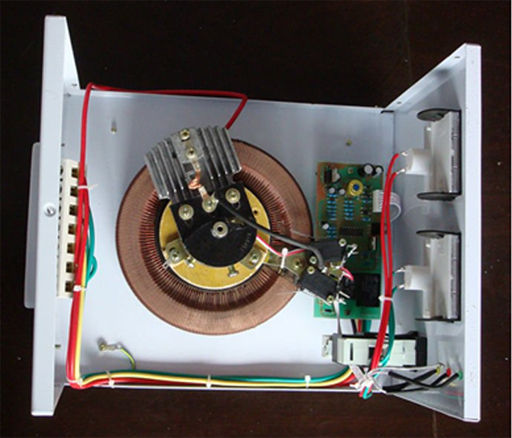22.09.2015
Taking into account the poor quality of electric power supplied by power supply organizations to consumers, the use of AVR becomes actual nowadays. The undervoltage of the network is the most frequent problem, which affects the operation of house hold appliances. The high voltage during strong power surge is able even to be a cause of fire. Today many consumers use expensive consumer equipment,which need the qualitative power supply. Automatic voltage regulators are practically the only and inexpensive protection of such equipment.
An alternating current automatic voltage regulator is a device, which supports voltage automatically in the consumer’s electric circuit with the prescribed accuracy.
Naturally, it is impossible to reach the ideal voltage stabilization, but it is not only possible, but it is necessary to reduce voltage destabilizing action to household appliances.
AVR can be classified according to the operating principle as follows:
• AVR with step-by-step regulation;
• ferroresonant AVR;
• electrically driven electromechanical AVR;
• AVR with magnetic bias of transformer;
• double power conversion systems;
• high-frequency transistorized regulators (AVR with discrete HF adjustment).
At present the most wide spread occurrence has automatic voltage regulators with the step-by-step regulation and electromechanical (servodrived) AVR.
Automatic voltage regulator with the step-by-step regulation. They have the step-by-step principle voltage regulation based on the automatic switching of autotransformer windings with the help of electromechanical relays or power keys (thyristors, symistors).
• operating speed (response time to the input voltage change makes less than 30 msec);
• wide range of input voltages;
• possibility to operate in the idle mode;
• absence of sinusoidal waveform distortion of output voltage;
• high coefficient of efficiency value.
Disadvantages:
• step-by-step output voltage change, which constrains stabilization accuracy. It is practically impossible to achieve the maintenance of stable voltage 220 V at the output. However, there is no need for this at all. Voltage deviation within ±10 % (198–242 V)is provided by the standard. Therefore,it should be taken into consideration, if figure 220 “has hardened” on the of output voltage indicator of AVR, then it is, more than likely, out of order!
This type of AVR is the optimum quality-to-price ratio when used in industry and in everyday life. An exception is the equipment, which require high accuracy of supply voltage.
Electromechanical automatic voltage regulators (servodrived) represent a system consisting of an autotransformer, servo motor and control system (unit) of the servo motor. Output voltage is controlled constantly, and when the voltage varies from its norm, the voltage value taken from the autotransformer and supplied to the load is changed. This scheme enables to regulate smoothly the voltage without the phase breaking and without harmonic distortion (this is very important for the exact electronic equipment). Winding switching in electromechanical AVR takes place due to a conducting brush, which is moved along the winding by a servomotor(electric motor). That is why the voltage stabilization speed at the output in such AVR depends on an electric motor and the quality of brushes. In automatic voltage regulators of special purpose the stabilization speed is equal to ~110 V/sec, in ordinary house hold AVR the actuation time can reach to 3 seconds.
• high control accuracy;
• absence of interferences;
• high overload capability;
• wide adjustment range.
Disadvantages:
• low response speed(response time makes approx. one second for 10 % of the voltage being corrected; it means that during the input voltage change,the time period after which the normal voltage is stabilized at the output, can make up to 3 seconds);
• limited life (these automatic voltage regulators have the permanent mechanical brush contact, which during permanent operation results in the wear of brushes and, as a result, in sparkling due to the bad contact);
• the availability of an open sliding electric contact limits a possibility of their use.
MAIN PARAMETERS, FUNCTIONS, OPERATING PRINCIPLES
Output power. A main parameter of automatic voltage regulators is the output power.
Electric power is a physical value,which characterizes the speed of transmission or conversion of electric energy.
Output power of AVR having been constructed based on an autotransformer is determined by the power of a used autotransformer. The transformer must provide a difference between input and output voltages. Because the transformer power is a permanent value, then the output power of AVR will change depending on the difference between input and output voltages. The more the voltage difference, the less load the AVR will be able to supply power.
Input voltage range, i. e. the power network voltage level, at which AVR provides the output voltage in the prescribed limits:
- operating range, when input voltage is within limits,which provides the declared stabilization value at the output, for example, 220 V ± 10 %;
- extreme range, when AVR ensures safe operation, but the output voltage differs from the declared value to the higher or lower side (within the limits of 15-18 %). When the output voltage exceeds the extreme value, AVR disconnects electrical appliances remaining connected to the power supply network to control a possibility to connect electrical appliances once again to the operation after returning the power supply network to the operating (extreme) range of voltages.
Accuracy of output voltage stabilization is the extreme voltage deviation at the AVR output (for example, 220 V ± 5 % means that there can be voltage from 209 to 231 V at the AVR output). The higher stabilization accuracy, the less output voltage spread.
Principle of AVR operation consists in tracking of input voltage changes and its adjustment at the output in accordance with a situation.
AVR SELECTION
To know if you really need an AVR, it is necessary to estimate voltage fluctuations in the power supply network. For this purpose, it is desirably to carry out voltage measurements in the network for some time, which will enable to select a required equipment in the optimum way. If a measuring device is absent, then the obvious signs of considerable voltage value change in the network are determined by change of incandescence of bulbs, equipment disconnection or failures in its operation.
It is recommended to select an automatic voltage regulator according to the following main operating characteristics:
• number of phases;
• AVR capacity;
• range of input voltages;
• response speed and voltage stabilization accuracy;
• additional functions;
• fastening/mounting method, dimensions, weight.
Three-phase automatic voltage regulators are designed to supply power to three-phase devices (used mainly at manufacturing enterprises). In residential areas (for example, in summer cottages),where three phases are available and standard household appliances are used, three single-phase automatic voltage regulators can be installed.
One of main characteristics of automatic voltage regulators is the power of connected loading, which serves as the main criterion for selection of one or another model of AVR. The automatic voltage regulator can be installed for a certain equipment, and well as to provide the operation of the whole object. That is why when selecting AVR it is necessary, first of all, to take into account the total power consumed by equipment connected to it. The total power consumed by a device consists of active and reactive powers, and their ratio depends on a load type. Data about the power consumption of devices are indicated, as a rule, in a technical passport or a user’s manual.
When installing a general AVR to provide power supply to a consumer group or for the whole equipment available in a house, it is also necessary to take into consideration a probability of the simultaneous turning on of all household appliances. Appliances equipped with electric motors (refrigerators, washing machines, conditioners, vacuum cleaners) are characterized by high starting currents. Besides electric motors, compressors and pumps have also high starting currents. Starting currents can exceed the nominal power of a device by several times.
It is recommended to select an AVR model with 20–30 % reserves of the load power consumption.
It is necessary to pay increased attention to the operating range of AVR. The most widespread is the range of input voltages 150–270 V. If the network voltage goes beyond these scopes, it is necessary to select AVR with wider range, for example, 100–270 or 150–310 V. It is also necessary to pay attention to the accuracy of maintenance by the device of the output voltage. In any case,the output voltage of AVR must not go beyond198–242 V (220 V ± 10 %).
For automatic voltage regulators with the step-by-step regulation switching time is normalized (must not exceed 20 milliseconds).
The following AVR functions can be important functions:
• protection against short circuit of the load (provides protection of AVR and power supply network accordingly in case of connection of defective devices);
• turn-on delay of devices-consumers (after power supply resumption in the network). Such function is required during the brief voltage drop in the network. Refrigeration and climatic equipment have special sensitiveness to such problems, as well as all home appliances with electric motors. Practically all automatic voltage regulators have the turn-on delay function of consumers (as a rule it is 6–10 seconds), the step increase of turn-on delay (up to 3 minutes) is additionally envisaged in some models. Moreover, after power supply resumption after relatively long interruption, the turn-on delay function blocks the simultaneous connection of all devices to the network, in such a way unloading the power supply network and preventing overloading of wiring;
• thermal protection of transformer (disconnects the loading in case of the transformer overheating, for example, due to the long operation in the overload mode);
• indicators (input and output voltages, overload). They enable a user to carry out visual control of the AVR’s operation modes.
Automatic voltage regulators with a capacity of more than 3000 VА are connected to the network with the help of terminal blocks (maximum permissible current of a standard home socket is 10 A or 16 А), less powerful AVR – with the help of standard plug.
Automatic Voltage Regulators
FUNCTION OF AUTOMATIC VOLTAGE REGULATORTaking into account the poor quality of electric power supplied by power supply organizations to consumers, the use of AVR becomes actual nowadays. The undervoltage of the network is the most frequent problem, which affects the operation of house hold appliances. The high voltage during strong power surge is able even to be a cause of fire. Today many consumers use expensive consumer equipment,which need the qualitative power supply. Automatic voltage regulators are practically the only and inexpensive protection of such equipment.
An alternating current automatic voltage regulator is a device, which supports voltage automatically in the consumer’s electric circuit with the prescribed accuracy.
Naturally, it is impossible to reach the ideal voltage stabilization, but it is not only possible, but it is necessary to reduce voltage destabilizing action to household appliances.

Automatic Voltage Regulator STAB-1000 |
CLASSIFICATION OF AUTOMATIC VOLTAGE REGULATORS
AVR can be classified according to the operating principle as follows:
• AVR with step-by-step regulation;
• ferroresonant AVR;
• electrically driven electromechanical AVR;
• AVR with magnetic bias of transformer;
• double power conversion systems;
• high-frequency transistorized regulators (AVR with discrete HF adjustment).
At present the most wide spread occurrence has automatic voltage regulators with the step-by-step regulation and electromechanical (servodrived) AVR.

|
Automatic voltage regulator with the step-by-step regulation. They have the step-by-step principle voltage regulation based on the automatic switching of autotransformer windings with the help of electromechanical relays or power keys (thyristors, symistors).

|
Advantages:
• operating speed (response time to the input voltage change makes less than 30 msec);
• wide range of input voltages;
• possibility to operate in the idle mode;
• absence of sinusoidal waveform distortion of output voltage;
• high coefficient of efficiency value.
Disadvantages:
• step-by-step output voltage change, which constrains stabilization accuracy. It is practically impossible to achieve the maintenance of stable voltage 220 V at the output. However, there is no need for this at all. Voltage deviation within ±10 % (198–242 V)is provided by the standard. Therefore,it should be taken into consideration, if figure 220 “has hardened” on the of output voltage indicator of AVR, then it is, more than likely, out of order!
This type of AVR is the optimum quality-to-price ratio when used in industry and in everyday life. An exception is the equipment, which require high accuracy of supply voltage.
Electromechanical automatic voltage regulators (servodrived) represent a system consisting of an autotransformer, servo motor and control system (unit) of the servo motor. Output voltage is controlled constantly, and when the voltage varies from its norm, the voltage value taken from the autotransformer and supplied to the load is changed. This scheme enables to regulate smoothly the voltage without the phase breaking and without harmonic distortion (this is very important for the exact electronic equipment). Winding switching in electromechanical AVR takes place due to a conducting brush, which is moved along the winding by a servomotor(electric motor). That is why the voltage stabilization speed at the output in such AVR depends on an electric motor and the quality of brushes. In automatic voltage regulators of special purpose the stabilization speed is equal to ~110 V/sec, in ordinary house hold AVR the actuation time can reach to 3 seconds.

|
Advantages:
• high control accuracy;
• absence of interferences;
• high overload capability;
• wide adjustment range.
Disadvantages:
• low response speed(response time makes approx. one second for 10 % of the voltage being corrected; it means that during the input voltage change,the time period after which the normal voltage is stabilized at the output, can make up to 3 seconds);
• limited life (these automatic voltage regulators have the permanent mechanical brush contact, which during permanent operation results in the wear of brushes and, as a result, in sparkling due to the bad contact);
• the availability of an open sliding electric contact limits a possibility of their use.
MAIN PARAMETERS, FUNCTIONS, OPERATING PRINCIPLES
Output power. A main parameter of automatic voltage regulators is the output power.
Electric power is a physical value,which characterizes the speed of transmission or conversion of electric energy.
Output power of AVR having been constructed based on an autotransformer is determined by the power of a used autotransformer. The transformer must provide a difference between input and output voltages. Because the transformer power is a permanent value, then the output power of AVR will change depending on the difference between input and output voltages. The more the voltage difference, the less load the AVR will be able to supply power.
Input voltage range, i. e. the power network voltage level, at which AVR provides the output voltage in the prescribed limits:
- operating range, when input voltage is within limits,which provides the declared stabilization value at the output, for example, 220 V ± 10 %;
- extreme range, when AVR ensures safe operation, but the output voltage differs from the declared value to the higher or lower side (within the limits of 15-18 %). When the output voltage exceeds the extreme value, AVR disconnects electrical appliances remaining connected to the power supply network to control a possibility to connect electrical appliances once again to the operation after returning the power supply network to the operating (extreme) range of voltages.
Accuracy of output voltage stabilization is the extreme voltage deviation at the AVR output (for example, 220 V ± 5 % means that there can be voltage from 209 to 231 V at the AVR output). The higher stabilization accuracy, the less output voltage spread.
Principle of AVR operation consists in tracking of input voltage changes and its adjustment at the output in accordance with a situation.
AVR SELECTION
To know if you really need an AVR, it is necessary to estimate voltage fluctuations in the power supply network. For this purpose, it is desirably to carry out voltage measurements in the network for some time, which will enable to select a required equipment in the optimum way. If a measuring device is absent, then the obvious signs of considerable voltage value change in the network are determined by change of incandescence of bulbs, equipment disconnection or failures in its operation.
It is recommended to select an automatic voltage regulator according to the following main operating characteristics:
• number of phases;
• AVR capacity;
• range of input voltages;
• response speed and voltage stabilization accuracy;
• additional functions;
• fastening/mounting method, dimensions, weight.
Three-phase automatic voltage regulators are designed to supply power to three-phase devices (used mainly at manufacturing enterprises). In residential areas (for example, in summer cottages),where three phases are available and standard household appliances are used, three single-phase automatic voltage regulators can be installed.
One of main characteristics of automatic voltage regulators is the power of connected loading, which serves as the main criterion for selection of one or another model of AVR. The automatic voltage regulator can be installed for a certain equipment, and well as to provide the operation of the whole object. That is why when selecting AVR it is necessary, first of all, to take into account the total power consumed by equipment connected to it. The total power consumed by a device consists of active and reactive powers, and their ratio depends on a load type. Data about the power consumption of devices are indicated, as a rule, in a technical passport or a user’s manual.
When installing a general AVR to provide power supply to a consumer group or for the whole equipment available in a house, it is also necessary to take into consideration a probability of the simultaneous turning on of all household appliances. Appliances equipped with electric motors (refrigerators, washing machines, conditioners, vacuum cleaners) are characterized by high starting currents. Besides electric motors, compressors and pumps have also high starting currents. Starting currents can exceed the nominal power of a device by several times.
It is recommended to select an AVR model with 20–30 % reserves of the load power consumption.
It is necessary to pay increased attention to the operating range of AVR. The most widespread is the range of input voltages 150–270 V. If the network voltage goes beyond these scopes, it is necessary to select AVR with wider range, for example, 100–270 or 150–310 V. It is also necessary to pay attention to the accuracy of maintenance by the device of the output voltage. In any case,the output voltage of AVR must not go beyond198–242 V (220 V ± 10 %).
For automatic voltage regulators with the step-by-step regulation switching time is normalized (must not exceed 20 milliseconds).
The following AVR functions can be important functions:
• protection against short circuit of the load (provides protection of AVR and power supply network accordingly in case of connection of defective devices);
• turn-on delay of devices-consumers (after power supply resumption in the network). Such function is required during the brief voltage drop in the network. Refrigeration and climatic equipment have special sensitiveness to such problems, as well as all home appliances with electric motors. Practically all automatic voltage regulators have the turn-on delay function of consumers (as a rule it is 6–10 seconds), the step increase of turn-on delay (up to 3 minutes) is additionally envisaged in some models. Moreover, after power supply resumption after relatively long interruption, the turn-on delay function blocks the simultaneous connection of all devices to the network, in such a way unloading the power supply network and preventing overloading of wiring;
• thermal protection of transformer (disconnects the loading in case of the transformer overheating, for example, due to the long operation in the overload mode);
• indicators (input and output voltages, overload). They enable a user to carry out visual control of the AVR’s operation modes.
Automatic voltage regulators with a capacity of more than 3000 VА are connected to the network with the help of terminal blocks (maximum permissible current of a standard home socket is 10 A or 16 А), less powerful AVR – with the help of standard plug.


